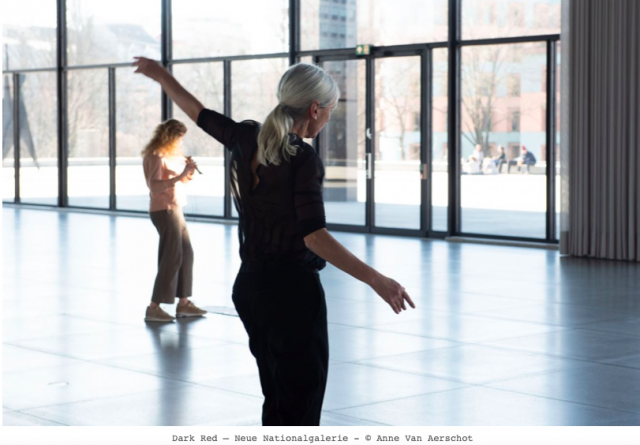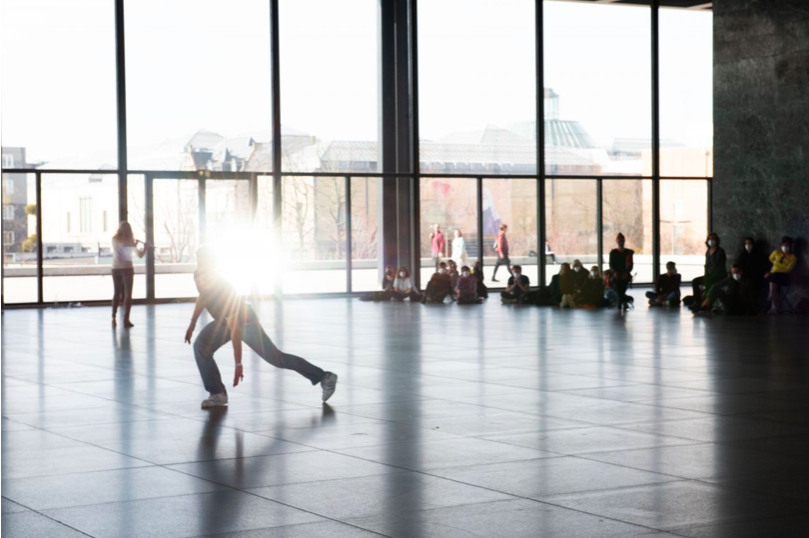
For the English version, please, scroll down
BERLINO – Nell’ambito del progetto Dark Red, che porta la danza nei musei, Anne Teresa De Keersmaeker ha presentato, dal 24 al 27 marzo, una coreografia appositamente creata per la Neue Nationalgalerie di Berlino. La performance, sviluppata in collaborazione con i danzatori Cassiel Gaube e Sea Ratsifandrihana, la flautista Chryssi Dimitriou e la visual artist Ann Veronica Jassens, consiste in un solo accompagnato dalla musica L’opera per flauto del compositore siciliano Salvatore Sciarrino.
Disposto in circolo, il pubblico aspetta che l’esibizione cominci
La prima a prendere la scena è proprio la coreografa belga che, sulle note del flauto, attraverso semplici e chiari movimenti delle braccia e del torso, inizia a dar vita allo spazio illuminato dalla luce naturale del giorno, che filtra dalle pareti di vetro della galleria. Il suo intervento è breve. Dopo poco si dirige verso l’ingresso del museo lasciando il campo a Cassiel Gaube. Lui, sembra tagliare l’aria con un gesto deciso del braccio, poi, muovendosi con passi di hip hop, attraversa lo spazio da un punto all’altro. Interagendo con la musica, si avvicina e poi si allontana da Chryssi Dimitriou, che per tutta la durata dell’esibizione, rivolge il suo sguardo verso l’esterno, senza mai guardare il pubblico.
Una “pausa” un po’ troppo lunga confonde gli spettatori
Segue un lungo momento in cui la danza si interrompe per lasciare che la musica riempi lo spazio. Forse questa ‘pausa’ è un po’ lunga, tanto che alcuni spettatori lasciano la sala. Quando Cassiel Gaube torna a muoversi, prima con dei tremori, poi con movimenti sempre più veloci e più ampi, lo fa ipnotizzando gli spettatori, portandoli in un posto lontano. Verso la fine, Anne Teresa torna in scena con spirali, chaînés e fouettés ‘contemporanei’ poi si incrocia con il danzatore della sua compagnia ‘Rosas’ e di nuovo lo lascia solo. Lui riprende la sua improvvisazione fino a concludere il pezzo all’esterno del museo.
La scelta di non riempire lo spazio con più danzatori, ma di riprodurre lo schema di un suo pezzo del 2015 Die Weise von Liebe und Tod des Cornets Christoph Rilke, è singolare ma efficace. Lo spettacolo, comunque, complice la bravura di Cassiel Gaube e la splendida location, risulta essere un esperimento molto bello ed elegante.

Dance at the Neue Nationalgalerie in Berlin
As part of the Dark Red project, which brings dance to museums, Anne Teresa De Keersmaeker presented, from March 24th to 27th, a choreography created for the Neue Nationalgalerie in Berlin. The performance, developed in collaboration with the dancers Cassiel Gaube and Sea Ratsifandrihana, the flutist Chryssi Dimitriou and the visual artist Ann Veronica Jassens, consists of a solo improvised on the music L’opera per flauto by the Sicilian composer Salvatore Sciarrino.
In the huge hall of the museum, the audience arranged in a circle waits for the exhibition to begin
The first to go on stage is the Belgian choreographer who, following the notes of the flute, through simple and clear movements of her arms and torso, brings life to the space, which is illuminated by the natural light that filters through the glass walls of the gallery. Her solo is brief. After a while she heads towards the entrance of the museum, leaving the field for Cassiel Gaube. He seems to cut the air with a decisive gesture of his arm, then, moving with hip hop steps, crosses the space from one point to another. Interacting with the music, he approaches and then moves away from Chryssi Dimitriou, who, for the entire duration of the performance, turns his gaze towards the outside, never looking at the audience.
A “pause” a bit too long confuses the audience
A long moment follows where the dance stops to let the music fill the space. Perhaps this break is a bit too long, so much so that some people from the audience leave the room. When Cassiel Gaube moves again, first with tremors, then with even faster and wider movements, he hypnotizes the spectators, taking them to a distant place. Towards the end, Anne Teresa returns to the scene executing spirals, chaînés and ‘contemporary’ fouettés. Then she crosses paths with the dancer of her company ‘Rosas’ and again leaves him alone. He resumes his improvisation until the end of the piece out of the museum.
The choice not to fill the space with more dancers, but to reproduce the scheme of a piece of hers from 2015 Die Weise von Liebe und Tod des Cornets Christoph Rilke, is singular but effective. The show, however, thanks to the skill of Cassiel Gaube and the splendid location, results to be a beautiful and elegant experiment.














































